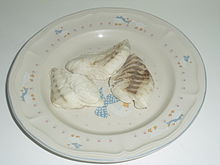
Plectorhinchus is a genus of marine ray-finned fish, sweetlips belonging to the subfamily Plectorhinchinae which is one of two subfamilies in the family Haemulidae which also includes the grunts. The species in this genus are found in fresh, brackish, and salt waters.

Plectorhinchus chaetodonoides, the harlequin sweetlips, clown sweetlips, spotted sweetlips or many-spotted sweetlips, is a species of marine ray-finned fish, a sweetlips belonging to the subfamily Plectorhinchinae, one of two subfamilies in the family Haemulidae, the grunts. It is native to the Indo-Pacific region. This species is of minor importance to local commercial fisheries and can be found in the aquarium trade.

The Indian Ocean oriental sweetlips, also known as the oriental sweetlips or oriental blubberlips, is a species of marine ray-finned fish, a sweetlips belonging to the subfamily Plectorhinchinae, one of two subfamilies in the family Haemulidae, the grunts. It is native to the Indian Ocean and the western Pacific Ocean.

Plectorhinchus polytaenia, the ribboned sweetlips, also known as Tesone di mare or yellow-ribbon sweetlips, is a species of marine ray-finned fish, a sweetlips belonging to the subfamily Plectorhinchinae, one of two subfamilies in the family Haemulidae, the grunts. It is native to the Indian Ocean and the western Pacific Ocean.

Plectorhinchus pica, the painted sweetlips, dotted sweetlips, magpie sweetlips or spotted sweetlips, is a species of marine ray-finned fish, a sweetlips belonging to the subfamily Plectorhinchinae, one of two subfamilies in the family Haemulidae, the grunts. It is native to coral reefs of the Indian Ocean and the western Pacific Ocean. It is a commercially important species and can be found in the aquarium trade.

Plectorhinchus diagrammus, the striped sweetlips, fourbanded sweetlips or silver-banded sweetlips, is a species of marine ray-finned fish, a sweetlips belonging to the subfamily Plectorhinchinae, one of two subfamilies in the family Haemulidae, the grunts. It feeds on benthic invertebrates. This species can reach 40 cm (16 in) in TL. It can be found in the aquarium trade and is farmed. It is native to the eastern Indian Ocean and the western Pacific Ocean, from the Andaman Islands to the Philippines, north as far as Japan, where it is an inhabitant of coral reefs. This species was first formally described in 1758 by Linnaeus in the 10th edition of the Systema Naturae, he gave it the name Perca diagramma. Its specific name diagrammus was not explained by Linnaeus but he cites Gronovius in his description who described “irregular longitudinal yellow lines”, so the name is inferred to “a figure marked with lines”.
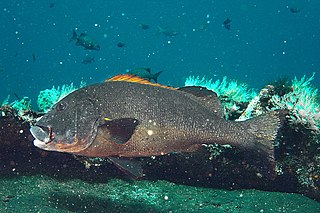
Plectorhinchus albovittatus, the two-striped sweetlips or giant sweetlips, is a species of marine ray-finned fish, a sweetlips belonging to the subfamily Plectorhinchinae, part of the grunt family Haemulidae. It is native to the Indian Ocean and the western Pacific Ocean.

Anisotremus virginicus, the porkfish, also known as the Atlantic porkfishsweetlips, dogfish or paragrate grunt, is a species of marine ray-finned fish, a grunt belonging to the family Haemulidae. It is native to the western Atlantic Ocean.

Diagramma is a genus of marine ray-finned fishes belonging to the family Haemulidae, grunts native to the Indian Ocean and the western Pacific Ocean. The currently recognized species in this genus are:
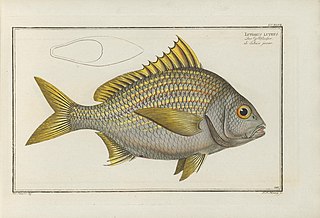
Genyatremus luteus, the Torroto grunt, is a species of marine ray-finned fish, a sweetlips belonging to the subfamily Plectorhinchinae of the family Haemulidae. It is native to the Atlantic coast of South America from Colombia to Brazil.

The blackfin slatey, also known as blackfoot sweetlips, blackfin sweetlips or blacktip sweetlips, is a species of marine ray-finned fish, a sweetlips belonging to the family Haemulidae. It is found in the eastern Indian Ocean and the western central Pacific Ocean.
Plectorhinchus macrospilus, the largespot sweetlips, largespot thicklips or Andaman sweetlips, is a species of marine ray-finned fish, a sweetlips belonging to the subfamily Plectorhinchinae, one of two subfamilies in the family Haemulidae, the grunts. It is native to the north eastern Indian Ocean.
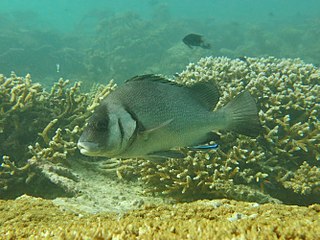
Plectorhinchus gibbosus, commonly known as the Harry hotlips, black sweetlips, brown sweetlips, dusky sweetlips, gibbous sweetlips, hairy hotlips or humpback sweetlips, is a species of marine ray-finned fish, a sweetlips belonging to the subfamily Plectorhinchinae, one of two subfamilies in the family Haemulidae, the grunts. It is native to the Western Pacific and Indian Oceans.
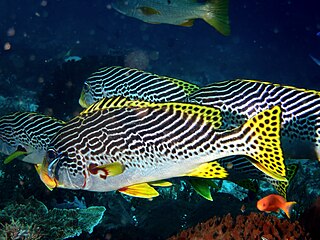
Plectorhinchus lineatus, also known as the yellowbanded sweetlips, oblique-banded sweetlips, diagonal-banded sweetlips, Goldman's sweetlips, lined blubber-lips, lined sweetlips, many-lined sweetlips, striped sweetlips and yellowband sweetlips, is a species of marine ray-finned fish, a sweetlips belonging to the subfamily Plectorhinchinae, one of two subfamilies in the family Haemulidae, the grunts. It inhabits coral reefs of the western Pacific Ocean, where it occurs at depths from 1 to 35 m.

Plectorhinchus caeruleonothus, the blue bastard, is a species of ray-finned fish belonging to the subfamily Plectorhinchinae, the sweetlips, one of two subfamilies in the family Haemulidae, the grunts. It was discovered in Australia in 2015.
Holorchis is a genus of trematodes in the family Aephnidiogenidae.

The sailfin rubberlip is a species of marine ray-finned fish, a sweetlips belonging to the family Haemulidae. It is found in the western Indian Ocean.

Diagramma centurio, the painted sweetlips, Australian slatey, greysweetlips, painted blubber-lips or yellowdot sweetlips, is a species of marine ray-finned fish, a sweetlips belonging to the family Haemulidae. It is found in the Indo-Pacific region.

The African striped grunt is a species of marine ray-finned fish, a sweetlips belonging to the subfamily Plectorhinchinae, one of two subfamilies in the family Haemulidae, the grunts. It is found in the eastern Atlantic Ocean.

The rubberlip grunt is a species of marine ray-finned fish, a sweetlips belonging to the subfamily Plectorhinchinae, one of two subfamilies in the family Haemulidae, the grunts. It is native to the eastern Atlantic Ocean.



